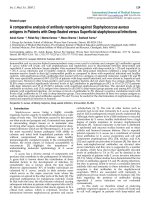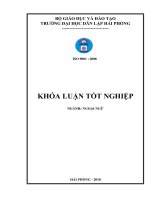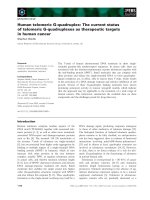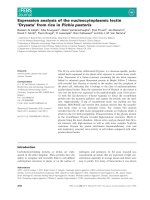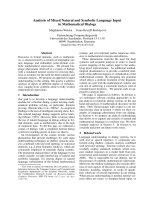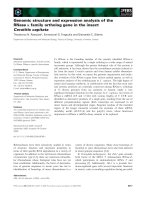Marketing analysis of cereal by-products used as livestock feed in Kano state, Nigeria
Bạn đang xem bản rút gọn của tài liệu. Xem và tải ngay bản đầy đủ của tài liệu tại đây (208.38 KB, 9 trang )
Int.J.Curr.Microbiol.App.Sci (2019) 8(2): 20-28
International Journal of Current Microbiology and Applied Sciences
ISSN: 2319-7706 Volume 8 Number 02 (2019)
Journal homepage:
Original Research Article
/>
Marketing Analysis of Cereal BY-Products used as Livestock
Feed in Kano State, Nigeria
S.A. Safiyanu1, Z.Y. Abdullahi1, I. Suleiman1, A. Salihu2* and H. Mohammed3
1
Department of Agricultural Economics and Extension, Kano State University of Science and
Technology Wudil, Nigeria
2
Department of Agricultural Economics, Institute of Agricultural Sciences,
Banaras Hindu University Varanasi, India
3
Department of Agricultural Economics and Management, Binyaminu Usman Polytechnic,
Hadejia, Jigawa State, Nigeria
*Corresponding author
ABSTRACT
Keywords
Cereals byproducts, Sorghum
bran and Maize
bran
Article Info
Accepted:
04 January 2018
Available Online:
10 February 2019
The study focused on the profitability analysis of marketing of cereals by-products used as
livestock feed in Kano State. Multistage sampling technique was used for the study and
data was collected using structured questionnaire supplemented with key informant
interview. A total of one hundred and seventy-eight (178) cereals by-product marketers
were sampled. The analytical tools employed included descriptive statistics, net marketing
margin analysis and marketing efficiency. The result of the socio economic characteristics
showed that 12% of the cereals by-products marketers were adult belonging to the age
group of 43-52 years, 51% of them had household size of 1-6 members, 43.8% of the
cereals by-products marketers had 14-22 years of marketing experience, 94.9% married
with 88.6% males, the result of educational background of legumes by-products marketers
in the study area shows that 44.9% had Qur'anic education. The result of the profitability
analysis revealed that cereals by-products marketing were profitable as the marketing
margin for sorghum bran and maize bran were N323.34 and N470 respectively. The total
revenue realized for the marketing were N1796.67 and N2083.33 for sorghum bran and
maize bran respectively. The result further revealed Gross Margin (GR) of 0.01 and 0.01
for sorghum bran and maize bran traded in the study area while return per naira invested
was found to be 1.09 and 1.16 accrued from every N1.00 invested for legumes by-products
marketing. The result also revealed that marketing of legumes by-products was efficient
with 254.17% and 306.16% for sorghum bran and maize bran respectively indicating that
marketing of these by-products was profitable and efficient in the study area. The study
recommended that since cereals by-product marketing is a profitable enterprise more youth
should be encouraged to venture into the enterprises this will go a long way in reducing
unemployment in the study area.
20
Int.J.Curr.Microbiol.App.Sci (2019) 8(2): 20-28
Nigeria is faced with a number of constraints
including relatively unorganized market and
inadequate feed markets (Powell 1984).
Introduction
Feeds are natural substances which are most
commonly organic matter with little
components of inorganic matter (Umar, 2002).
Livestock feeds are both organic and inorganic
substances taken in by animals to provide
nutrients such as energy, proteins, minerals
and vitamins, metabolized in the body to
maintain and produce body tissues, fluids and
by-products such as meat, milk and eggs. The
feed industry is one of the most competitive
businesses in the agricultural sector and is by
far the largest purchaser of U.S. corn, feed
grains and soybean meal (FAO, 2001).
Materials and Methods
The study was carried out in Kano State,
Nigeria. The state lies on latitudes 100 331N to
120371N and Longitude 70 401E to 90 291E. It
is within sudan savannah zone; the total land
area of the state is 20,760 square kilometers.
The mean daily maximum and minimum
temperature are 91.60F (33.10) and 60.60F
(15.85OC) respectively. Kano state is bordered
to the north and northwest by Katsina state, to
the east and northeast by Jigawa state, to the
south by Bauchi state and to the southwest by
Kaduna state. According to the official gazette
of Federal Republic of Nigeria (2007), the
state had a [population of nine million three
hundred and eighty-three thousand six
hundred
and
eighty-two
(9,383,682)
inhabitants, with an annual growth rate of
3.3%, who are mainly Hausa and Fulani by
tribe (NPC, 2006).
Studies in various part of Nigeria revealed that
about 31% of the Nigerian land area is
cropped and different ranges of livestock feeds
are produced (Abubakar, 1998). Livestock
feeds are of two types those from cereal
(millet bran, sorghum bran and maize bran)
and those from legume (cowpea vines,
groundnut hay and soybean) (Benerjee, 2005).
Marketing provides the mechanism whereby
producers exchange their commodity for cash.
The cash is used for acquiring goods and
services which they do not produce
themselves, in order to satisfy a variety of
needs ranging from food items, clothing,
shelter, medication and schooling to the
purchase of breeding stock and other
production inputs and supplies (Solomon and
Nagussie, 2002). Agricultural marketing from
micro view point is the performance of all
business activities which direct the forward
flow of goods and services to consumers in
order to accomplish producer’s objectives
(Olukosi et al., 2007).
Major crops grown in the state includes millet,
sorghum, maize, rice, wheat, cotton, gum
Arabic and groundnut etc. Their by-products
are significant source of food to livestock
while rearing of animal like cattle, horses,
goats and sheep were more pronounced (RIM,
1992). The state has quite large number of
markets. These include rural and urban
markets where agricultural commodities are
assembled including livestock and their feeds.
Most of the market operates weekly or twice a
week with the exception of urban markets
which operate daily. Kano state is currently
made up of forty-four Local Governments
Area (LGAs) and the state is agriculturally
classified into three (3) zones by the Kano
State Agricultural and Rural Development
Authority (KNARDA, 1995). Legumes byproducts marketers are found in all the three
ADPs zones of Kano state (KNARDA, 2001).
Livestock feed markets suffered from neglect
in marketing services in spite of their
importance to household welfare and national
economy as a whole simply because their full
potential is fairly realized. The marketing of
industrial and agricultural by-products in
21
Int.J.Curr.Microbiol.App.Sci (2019) 8(2): 20-28
ultimate consumer (Olukosi et al., 2007). The
model is specified as follows:
Sampling method
A multistage sampling technique was used for
data collection in the study area. For this study
all the three (3) Zones was considered. The
first stage involved purposive selection of two
local government areas from each zone based
on relative abundance and high intensity of
feed marketers. On that basis, Rano and Kura
local government areas were chosen from
zone I, Danbatta and Shanono local
government areas were chosen from zone II
and Wudil and Tarauni local government areas
were chosen from zone III. The second stage,
involved purposive selection of one market
from each of the selected local government
based on the size, location and high
involvement in feed marketing. On that basis,
Rano and Kura markets were selected from
zone I, Danbatta and Shanono markets were
selected from zone II and Wudil and
Unguwauku Yan awaki markets were selected
from zone III. The third stage, involved
random selection of respondents from the six
selected markets. A pre-survey was conducted
and a total of 595 marketers were identified
from all the markets out of which 30% was
considered from each of the selected markets.
In the last stage, a total of 178 respondents
were randomly selected using flip papers in
the study. In each market, the marketers were
first identified and a list was prepared, a ballot
box method was applied in selecting the
marketers.
Net Marketing Margin (NM)=TR–TMC---(i)
Where:
NMM =Net Marketing margin
TMC =Total
Marketing
(C1+C2+C3+C4+C5)
Cost
Where: C1 = Cost of Transportation (N)C2 =
Cost of labor (N),C3 = Marketing charges(N),
C4 = Storage (N) andC5 = Commission Fee
(N)
Gross ratio
It is a ratio that measures the overall financial
success of a business. A less than 1 ratio is
desirable for any business, the lower the ratio
the higher the profit (Olukosi and Erhabor,
2008). It is stated as:
GR= TMC---------(ii)
TR
Where,
GR = Gross Ratio
TMC = Total Marketing Cost
TR = Total Revenue
Operating ratio
It measures the solvency of a business. A ratio
less than 1 is desirable because it indicates that
the business is making profit. A ratio of 1
implies break-even and a ratio greater than 1
implies a loss (Olukosi and Erhabor, 2008).
According to Musa et al., (2006), the lower
the ratio (<1) the higher the profitability of the
business. It is given as:
Analytical tools
The tools of analysis used for this study are:
Descriptive statistics, Marketing margin
analysis and Marketing Efficiency.
Marketing margin analysis
OR = TVC ---------(iii)
TR
It is the difference in prices of a commodity at
different stages of time, place, form and
possession as it moves from producer to the
Where,
22
Int.J.Curr.Microbiol.App.Sci (2019) 8(2): 20-28
OR = Operating Ratio
TMC = Total Variable Cost
TR = Total Revenue
status, reason for livestock feed marketing,
nature of business, years of experience in
livestock feed marketing and benefits derived
from association. The results are presented in
Table 1a shows that the ages of the
respondents’ ranges from 23-32 years with an
average of 44years. The results further
revealed that adult of age group of 43–52
years were the highest with 43.1%, while least
percentage of 2.3% goes to age group of 63-72
years. The implication of this finding is that,
middle aged take part more in livestock feed
marketing than old aged and younger ones in
the study area. This tally with the finding
force work of Osotimehin (2006) that trader’s
age affects their efficiency in performing
managerial decisions. Household size is one of
the socio economic variables that may
influence the level of participation in legumes
by-product marketing. The result in Table 1a
revealed that majority of the livestock feed
marketers 51% had household size of 1– 6
members and 8.5% goes to household size of
13-30 members. Thus, majority of the
respondents in the study area are having less
household size because the business is more of
middle aged who have less family size than
the old ones. Marketing experience is the
number of years that the marketers spent in
livestock feed business. The longer the
experience in the business, the better the
performance in livestock feed marketing. The
result indicated that most of the respondents
43.75% had a marketing experience of 14-22
years while 6.25% of the respondents had
marketing experience of 32-49 years. This
implies that livestock marketers can manage
risk and make sound decision in managing
cereal and legume by products used as
livestock feed to enhance better performance.
Return on capital invested
Return on capital invested is defined as total
income or revenue divided by total marketing
cost (Olukosi et al., 2005). It is given as:
RNI=TR ---------------- (iv)
TMC
Where,
RNI = Return on Capital Invested
TR = Total Revenue
TMC = Total Marketing Cost
Marketing efficiency
Marketing efficiency measures the ratio of
output to input i.e. the maximization of the
ratio of output to input marketing (Olukosi et
al., 2007). The higher the ratio, the higher was
the marketing efficiency and vice versa. The
formula is specified as:
M.E =Value added by marketing X 100----(vi)
Cost of marketing services
Thus:
Value Added by marketing (VA) = Sp – Pp
Where:
Sp = Selling price of the commodity (in naira)
Pp = Purchase price of the commodity (in
naira)
Results and Discussion
Socio
economic
respondents
characteristic
of
Gender is an important socio-economic
parameter which gives the proportion of
respondents according either male or female
(Ekong, 2003). The study revealed that both
male and female were involved in livestock
The study examined the socio-economic
characteristics of the respondents’ such as age,
sex, marital status, household size, educational
23
Int.J.Curr.Microbiol.App.Sci (2019) 8(2): 20-28
feed marketing with male having 88.6% while
female constitute 11.4% as presented in Table
1b. The few size of female traders
participating in livestock feed marketing may
be due to religious and cultural barrier in the
study area.
society. Education is very important in every
aspect of life and it plays a fundamental role
towards agricultural development, it enhances
easy assimilation, awareness and receptivity to
innovations of agricultural practices. Thus,
education gives a better awareness, persuasion
and adoption of innovation hence better
improvement in production and marketing
(Adams, 1992). The result in Table 1b
indicated that 44.9% of legume by-products
marketers had Qur’anic education while 1.1%
had tertiary education having the least
percentage. This may be due to the nature of
the enterprise which is dominated by people
from rural areas.
It was observed that men generally participate
more in production and marketing aspect of
agriculture than women who participate more
in agro-processing (Ekong, 2003). This agrees
with finding of (Ewa and Ago, 1998) who said
“economic status and contribution of women
is less in developing countries due to
continuous dependent on their male
counterparts and the social setting of their
Table.1a Socio Economic characteristics of cereal by-products marketers
Variables
Age
23-32
33-42
43-52
53-62
63-72
Total
Mean 44.35
Household size
1-6
7-12
13-18
19-24
25-30
Total
Mean 7.3
Marketing experience
5-13
14-22
23-31
32-40
41-49
Total
Mean 17.64
Frequency Percentage
3
60
77
32
4
176
Min 23
1.7
34.7
43.1
18.2
2.3
100
Max 68
SD 7.793
89
72
12
2
1
176
Min 1
50.6
40.9
6.8
1.13
0.57
100
Max 29
SD 4.112
69
77
19
9
2
176
Min 5
39.20
43.75
10.8
5.11
1.14
100
Max 45
SD 7.62
Source: field survey, 2013
24
Int.J.Curr.Microbiol.App.Sci (2019) 8(2): 20-28
Table.1b Socio economic characteristics of cereal by-products marketers
Variables
Frequency
Percentage
Male
156
88.6
Female
20
11.4
Total
176
100
Primary
32
18.2
Secondary
60
34.1
Quranic
79
44.9
Adult
3
1.7
Tertiary
2
1.1
Total
176
100
Married
166
94.9
Single
3
1.7
Divorced
3
1.7
Widow
3
1.7
Total
176
100
Member
33
18.8
None member
143
81.2
Total
176
100
14
45.2
Source of information 10
32.3
Gender
Level of education
Marital status
Association
Membership
Benefits
association
from
Helping one another
Source of credit
7
22.6
Total
31
100
Source: field survey, 2013
25
Int.J.Curr.Microbiol.App.Sci (2019) 8(2): 20-28
Table.2 Profitability analysis per 114kg of sorghum bran and 116kg of maize bran used as
livestock feed
Sorghum bran
Maize bran
Value (N /kg)
% TMC
Value (N /kg)
% TMC
Purchase price
3683.33
93.05
1613.33
89.46
Transportation cost
125
3.16
50
2.77
Storage cost
50
1.26
30
1.66
Cost of labour
80
2.02
90
4.99
Marketing charges
20
0.51
20
1.11
Total Marketing Cost
3958.33
100
190
100
Total Revenue
4375
2083.33
Gross Ratio
0.01
0.01
Operating Ratio
0.90
0.87
Marketing Margin
416.67
280
Parameters
Marketing Cost (MC)
1893.33
Net Marketing Margin
RNI
1.10
1.16
Marketing Efficiency (%)
168.61
306.16
Source: Field Survey, 2013
The finding of this study tally with (Bivan,
1995) who reported that education attendant
is paramount in respondent’s decision
making. The result in Table 1b further
revealed that majority of the livestock feed
marketers 81.2% were membership to an
association while 18.8% of the traders were
no having membership to an association. The
result also reveals that 45.2% of the members
benefited from the association in helping one
another, 32.3% benefited with source of
information while 22.6% benefited with
credit. Imoudu and Afolabi (2002) posited
that the market structure for agricultural
products in Nigeria is not perfectly
competitive due to the collusive tendencies of
sellers by forming associations for particular
products.
Profitability of marketing cereal
products used as livestock feed
by-
The profitability measures such as the
marketing margin, net marketing margin
(NMM), marketing revenue and return to
naira invested (RNI), gross ratio (GR) and
operating ratio (OR) were determined and
presented in Table 2. The results revealed that
the total sales per year of Sorghum brand and
Maize brand were ₦332,383.98 and
₦385,416.08 respectively. The return to naira
investments of 1.09 and 1.16 for Sorghum
brand and Maize brand implies that a profit of
₦0.09 and ₦1.16 would return to the invested
respectively. The result further revealed gross
ratio (GR) of 0.01 and 0.02 for Sorghum
brand and Maize brand traded. The ratios
were all less than unity. A less than 1 ratio is
26
Int.J.Curr.Microbiol.App.Sci (2019) 8(2): 20-28
preferable for any farm business, Olukosi and
encouraged to venture in to the enterprises
Erhabor, (2008) posited that the lower the
this will go a long way in reducing
ratio the high the profit impliedly, Sorghum
unemployment in the study area.
brand and Maize brand were profitable in the iii. There is need for government and its
study area. In similar vein, the operating ratio
development partners to encourage people
(OR) of Sorghum brand and Maize brand
to go into farming so that there will be an
were obtained as 0.91 and 0.87 respectively.
increase in the quantity of cereals which
Operating ratio of both commodities was
subsequently lead to an increase in the
lower than unity. Olukosi and Erhabor, (2008)
availability of livestock feeds.
also reported that a ratio less than one
indicates that the marketers are marking
References
profit.
Abubakar, M.M. (1998) “Utilization of
The results in Table 2 show the marketing
Unconventional
Feedstuffs
for
efficiencies of Sorghum brand and Maize
Sustainable Livestock Production”
brand used as livestock feed was found to be
Inaugural Lecture Series No. 09.
254.17% and 306.16% respectively. The
Delivered at the Abubakar Tafawa
result further revealed that Maize brand has
Balewa University, Bauchi State,
the highest marketing efficiency as compared
Nigeria on 30th March, 1998.
to Sorghum brand in the marketing of cereals
Adedoyin, A.J. and Dittoh, J.S. (1997).
by-products in the study area. The higher the
Essential of Agricultural Economics,
ratio the higher the marketing efficiency and
Centre for Agricultural Development
vice versa (Olukosi, et. al., 2007).
(CERD), Ibadan, Nigeria. Pp. 48-50.
Benerjee, G C. (2005). Animal Husbandry
In conclusion, the prospect of cereal byEight Edition. Oxford and IBH
products marketing in Kano state were found
Publishing Co. Pvt. Ltd. New Delhi,
to be full time occupation providing
pp 657-659.
employment for a large number of
Central Bank of Nigeria (1999): CBN Annual
individuals. This could be attributed to the
Report of 1998, Lagos Nigeria, Vol.10
amount of profits realized in both activities.
page 41.
The socio economic characteristics that
Federal Republic of Nigeria, (2007). Official
enhance higher marketing of cereal byGazette. No24 Volume 94 Published
products marketers were age, household size,
by the Federal Government Printer,
years of experience and level of income.
Lagos, Nigeria.
Food and Agricultural Organisation (2001).
FAO
Production
Year
Book:
Recommendation
FAOSTAT, Volume 49, No. 130. pp
Based on the findings of the study the
39-41.
following recommendations were made:
Kano State Agricultural and Rural
Development Authority (KNARDA)
i. Cereal by-products marketers should form
Headquarters, Kano, 1995. Bulletin,
strong and viable corporative groups which
Kano, Nigeria. Pp 1-5
will make them have access to institutional
Kano State Agricultural and Rural
support.
Development Authority (KNARDA)
ii. Since cereal by-products marketing is a
Headquarters, Kano 2001 Bulletin. Pp
profitable enterprise more youth should be
11-19.
27
Int.J.Curr.Microbiol.App.Sci (2019) 8(2): 20-28
Lakpini, C.A.M. (2002). Feed and Feeding
Strategies for Small Ruminant in
various Stages NAPRI, Shika, Zaria,
Nigeria. Pp 40 – 46.
National Population Commission (2006),
Census Report. Pp 30-35.
Olukosi, J.O. (2007). Introduction to
Agricultural marketing and Prices:
Principles and Application. 3rd Edition
Living Books Series G. U. Publishers,
Abuja, Nigeria.
Olukosi, J.O. Isitor, S.U. and Moses, O.O.
(2005). Introduction to Agricultural
Marketing and prices: Living Books
Series G. U. Publishers, Abuja,
Nigeria. Pp. 46-47.
RIM, (1992). Nigerian National Livestock
Resource Survey. (Vol. IV) Report by
Resource Inventory and Management
Limited (RIM) to FDL and PCS,
Abuja, Nigeria. Retrieved from
http:/www.fao.org/wairdocs/ILRI/*55
48E/*5548e09.htm#TopOfpage.
October, 2012.
Umar, A.N. (2002). The Voluntary Intake and
Digestibility Combinations of Crop
Residues and Legume Hay for Sheep.
Umar, M.I. (2007). By-product of Cereals and
Pulses used as Livestock Feed in Kano
Metropolis. An Unpublished B.Sc.
Agricultural Project Submitted to the
Department of Animal Science, Kano
University
of
Science
and
Technology, Wudil. Pp. 30.
How to cite this article:
Safiyanu, S.A., Z.Y. Abdullahi, I. Suleiman, A. Salihu and Mohammed, H. 2019. Marketing
Analysis of Cereal BY-Products used as Livestock Feed in Kano State, Nigeria.
Int.J.Curr.Microbiol.App.Sci. 8(02): 20-28. doi: />
28
